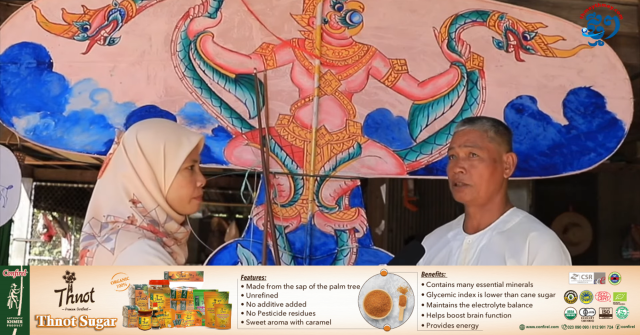Khlaeng Ek: A Cambodian Kite that Sings above the Rice Fields

- By Isa Rohany
- and Thorng Broney
- January 27, 2024 7:00 PM
SIEM REAP — As a cool breeze blows across the newly-harvested paddy fields and the morning fog starts to let sunrays break through in between the towering palm trees, flying objects take to the sky, hovering gently and silently in the wind on top of villages. This is January and, during the windy season that began in December, Cambodians are getting their kites to fly in the sky.
_1706330188.png)
Kites of different sizes fill the blue sky and among them is a klaeng ek, a giant kite of complex geometry and exceptional beauty.
Going back generations, the traditional art of making kites is associated with times of relaxation for villagers. They would get together to make them, the community assembling around this activity and unwinding after months of hard work ploughing the fields.
_1706330301.png)
However, in recent times, this tradition has slowly faded away in the country, and especially among the younger population.
Having learned from the old kite makers, Chhum Mao, who is now 64 years old, has been practicing the traditional art of making klaeng ek kites, for nearly two decades. In addition to his duties as a Buddhist monk, he is part of a Siem Reap theatre company that performs the shadow puppet theatre Sbek Thom—a form of Cambodian theatre inscribed on the UNESCO Intangible Cultural Heritage list.
_1706330387.png)
Standing next to his kite in the village of Svay Prei, which is located Svay Dangkum commune in Siem Reap province, Chhum Mao spoke of his passion for this old artform and his efforts to make sure Cambodians keep riding kites in the wind.
Isa Rohany: It has been said that the techniques for making kites have been passed on from one generation to the next in the country. In your case, when did you first discover kites and the art of making them?
Chhum Mao: Although I took this tradition much more seriously from 2007 on, my first encounter with a klaeng ek took place when I was around 10 years old. My grandfather made kites in his free time during the windy season when people had finished their farmwork.
Working under a nearby tree because his house was not big enough, my grandfather would ask me to help and pass on to him the tools he needed when he was making kites. When the Pol Pot regime [and Khmer Rouge genocide of 1975 to 1979] took place, the tradition was largely abandoned.
Decades later, when the cultural administrator of the province came to ask me about the art of making kites in 2007, this sparked my memory. At first, I did not really remember how to make a klaeng ek. However, after multiple attempts, through trials and errors, I began to pick up speed.
_1706330425.png)
Isa Rohany: How hard is it to make a klaeng ek compared to regular kites?
Chhum Mao: It is geometrically harder, and it requires more understanding of the material of choice. To begin with, the craftsman needs to find and know how to work with bamboo. There is an old saying that goes: “one village finds a clump of bamboo, a clump of bamboo produces one good bamboo stem, a good bamboo stem makes a good bamboo section.” This means the right bamboo is hard to find.
The bamboo has to be flexible enough to bend, yet stiff enough to hold on. Furthermore, good bamboo also creates an enjoyable flying experience.
Looking at the main frame of the kite here, we can see two important structural components: the kite’s backbone and the wing strut. In the past, older people used one continuous strut that could curve without being damaged to create the shape of the wing.
Today, as quality bamboo is harder to find, I have improvised the strut with two pieces joined together. At the same time, it is also easier to transport on long distances as they can be swiftly disassembled and put in a car.
_1706330504.png)
Isa Rohany: What is the usual size of a klaeng ek?
Chhum Mao: Normally, it is around 2.2 metres from wing to wing and 2.4 metres from top to bottom. Some can be smaller depending on the buyers’ choice. The smaller ones can be around 1-to-1.5 metre.
Real estate companies that sell land frequently purchase my kites and fly them to attract buyers. Film studios also buy some of my kites for their film productions.
_1706330648.png)
Isa Rohany: How much would you normally charge per kite?
Chhum Mao: Depending on the preferences of the customers, each kite can cost somewhere around $200. At the end of the day, I still need to also pay the painter because I do not know how to paint myself.
_1706330722.png)
Isa Rohany: So, how long does it take for you to make a kite?
Chhum Mao: Finding and preparing the bamboo is the harder part. After choosing the best ones, bamboos have to be split and carefully sun-dried for around 30 days. Then, we have to soak them in clean water for another 5 days before drying them again for an additional 15 days or so. The water has to be clearly decontaminated or else the bamboo will be unusable. Once the bamboo is processed, the assembly is fairly easy to do, taking only about 3 days to fully complete. I have to make sure that each part is balanced and calibrated to the intricacy of weight and shape. That means I have to trim them little by little until they work perfectly.
_1706330682.png)
Isa Rohany: Are any young people in the village intending to learn this art of making Klaeng Ek?
Chhum Mao: Yes, I am trying to ensure that I will find three to five people of the younger generations who can keep this art alive for the future. However, market demand and the lack of budget remain issues.
I am particularly happy to preserve this tradition. Sometimes, I did not even join my wife for lunch because I was eager to finish the work. Furthermore, I also want to preserve the shadow puppets [of the theatre Sbek Thom] in which I am currently involved.
_1706330771.png)
Singing in the wind
When gliding in the sky, a klaeng ek produces a distinct loud sound through its so-called “tongue” when coming into contact with moving air.
On some rare occasions, kite makers of the past could produce seven different notes with various sizes of kite tongues and the amount of wind blowing.
“The tongue of the kite is made of rattan,” Mao said. Making a kite tongue also requires patience and a number of stages to follow including step-by-step trimming and sun-drying to get the moisture out.
As in the case of a musical instrument, the sound changes depending on the length, the thickness, and the stiffness of the rattan. Usually, a shorter and thinner tongue makes a lower pitch sound and vice-versa.
Conducted in Khmer language for ThmeyThmey News, the interview was translated by Luy Sireyreaksa for Cambodianess News.
The interview (and the sound of the kites) can be seen on video in Khmer at:
https://www.youtube.com/watch?v=jStv6LzurVs&t=396s
https://www.youtube.com/watch?v=b3j3mGWzoZA















